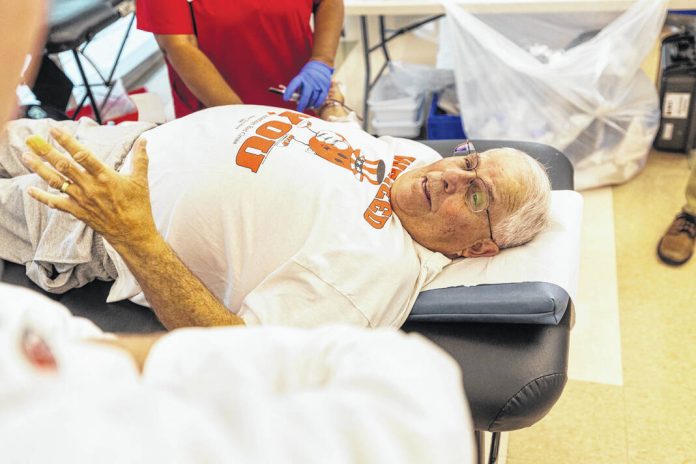PHILADELPHIA — Marc Satalof donated blood the first time in case his mother, who was undergoing surgery, needed it.
She didn’t. But the experience seemed like an easy way to help others, so Satalof decided to do it again. And again.
More than 50 years later, the Upper Gwynedd resident donated blood for the 280th time on Wednesday. Having reached a lifetime total of 35 gallons, he is calling it quits.
“I’m retiring,” he said.
At age 76, Satalof’s hemoglobin levels aren’t what they used to be, meaning his blood has a diminished capacity for carrying oxygen. He takes iron pills to counteract that trend, and as a result, his blood still meets the threshold for him to donate. But after consulting his primary care physician at Penn Medicine Radnor, Satalof decided that 35 gallons — a small bathtub’s worth of crimson fluid — was a good stopping point.
Satalof has rolled up his sleeve in schools, community centers, synagogues, and mobile blood-collection units, in recent years using a Red Cross smartphone app to track his total donations and schedule appointments. He always signed up to give his next pint as soon as he could manage, once he had waited the required eight weeks.
A retired teacher and principal in the Philadelphia public schools, he jokingly refers to his blood type, A-positive, like a top grade from a report card.
“I am A-plus,” he said. “I’ve donated just about everywhere there is. Even buses.”
On Wednesday, he did it at a Red Cross blood drive at Penn’s Perelman Center for Advanced Medicine.
He wasn’t looking for any extra credit. The idea to invite the media came from his primary care physician, Penn’s Kristin G. Christensen, who thought it would encourage others to donate.
Satalof agreed. He has long been promoting blood donation in other ways, speaking at Red Cross events and organizing blood drives at work and in the senior development where he lives with his wife, Elyse.
Still, he told staffers at the blood drive that he was worried about creating a fuss.
“I really apologize to all of you for this disruption,” he said.
Plasma and platelets
Other than the cameras, it was the same procedure Sataloff had been through at least 279 times before. (The records from his early years of donating, in the late 1960s, are a little spotty, so his total may be even higher.) He answered a few questions about his health, then lay down on a cot so that Silvia Vargas, a Red Cross collections specialist, could swab his forearm with disinfectant and insert the needle into a vein.
As his blood trickled into a collection bag, Satalof chatted with Donald L. Siegel, director of transfusion medicine at the Hospital of the University of Pennsylvania. The physician said every year the hospital uses 65,000 units of component products that are extracted from the blood of donors like Satalof: plasma, red blood cells, or platelets, depending on the need. Trauma centers, such as the one at nearby Penn Presbyterian Medical Center, also use whole blood.
Satalof’s 280 pints may have been used in the treatment of up to 1,000 patients.
“It’s a precious resource,” the physician said.
Elyse Satalof stood to one side. She and Marc met in junior high school, went to Temple University together, then got married and worked for 33 years in the Philadelphia schools, retiring on the same day in 2002.
She is not a blood donor, as she doesn’t like needles. But she has supported her husband’s donations from the start, satisfied that he has all the facts and has consulted his doctors.
“He’s pretty astute,” she said.
Red Cross volunteer
Marc Satalof thinks he gave his first donation in 1968 or 1969. Not only did his mother not need the extra blood at the time during her surgery, she recovered so well that she is alive today, at age 101.
Though Wednesday was Satalof’s last donation, he said he might continue to volunteer for the Red Cross “in another vein.”
He started to list the possibilities, then laughed as he realized what he’d said.
“That was unintentional,” he said. “Ha!”
After his blood bag was full, he got up from the cot and thanked everyone, hugging several Red Cross staffers on his way out.
His app did not update immediately. But he was confident that within a few hours, it would show the correct total after his red-letter day: 280 pints, 35 gallons.







